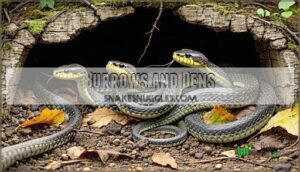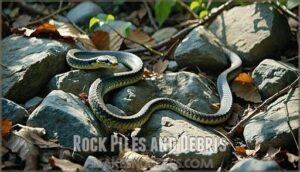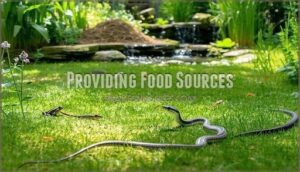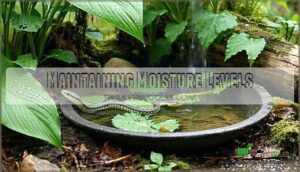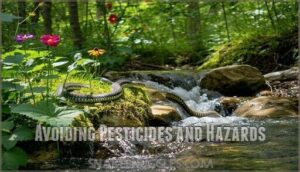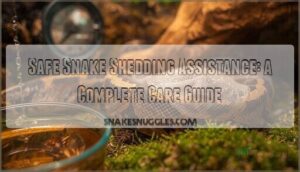This site is supported by our readers. We may earn a commission, at no cost to you, if you purchase through links.
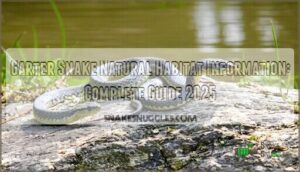 You’ll find garter snakes thriving in diverse environments across North America.
You’ll find garter snakes thriving in diverse environments across North America.
These adaptable reptiles call meadows, gardens, woodlands, and wetland edges home.
They’re particularly drawn to areas near water sources like streams, ponds, or marshes.
When it’s time to rest or hibernate, they seek shelter under rocks, logs, stone walls, or building foundations.
Garter snakes prefer loose, well-draining soil that retains some moisture.
You might spot them basking on warm surfaces during cooler mornings or hunting for earthworms after rain.
Their habitat needs vary slightly by species, but most appreciate a mix of open spaces for hunting and dense cover for protection.
Understanding these preferences reveals fascinating insights about their seasonal movements and survival strategies.
Table Of Contents
- Key Takeaways
- Garter Snake Habitat
- Snake Nesting Preferences
- Creating Snake Friendly Yards
- Garter Snake Behavior
- Conserving Garter Snakes
- Frequently Asked Questions (FAQs)
- Is it good or bad to have garter snakes in your yard?
- How to make a garter snake habitat?
- Where do garter snakes like to nest?
- How long do garter snakes typically live?
- What predators commonly hunt garter snakes?
- Are garter snakes venomous or dangerous?
- How can you identify different garter snake species?
- When do garter snakes give birth?
- Conclusion
Key Takeaways
- You’ll find garter snakes thriving in diverse environments from meadows and gardens to wetlands and urban parks, making them North America’s most widespread snake species
- They need loose, well-draining soil that retains moisture, plus shelter options like rock piles, logs, or dense vegetation within 100 yards of reliable water sources
- You can create snake-friendly yards by providing natural prey (earthworms, slugs), building brush and rock piles for shelter, maintaining moisture levels, and avoiding pesticides
- These beneficial reptiles control garden pests naturally and indicate healthy ecosystems, so protecting their habitats through native plantings and wetland preservation supports entire food webs
Garter Snake Habitat
You’ll find garter snakes thriving in remarkably diverse environments, from backyard gardens and meadows to forests, wetlands, and even urban parks across North America.
These adaptable reptiles have mastered the art of making themselves at home in nearly any habitat that offers adequate food, water, and shelter, which makes them highly diverse in their choice of living spaces.
Types of Habitats
While you’ll find garter snakes thriving in diverse environments, they show remarkable adaptability across five main habitat types.
Aquatic habitats include marshes, wetlands, and stream edges where they hunt amphibians and fish.
Terrestrial habitats encompass meadows, grasslands, and prairies with abundant ground cover.
Urban habitats feature gardens, parks, and suburban yards with water sources nearby.
Microhabitats provide essential shelter through rock piles, logs, and dense vegetation for protection and temperature regulation.
They’re also beneficial because they provide natural pest control by consuming slugs.
Geographic Distribution
You’ll find garter snakes across an impressive garter snake distribution spanning from central Canada to Costa Rica.
Their snake geographical range covers all lower 48 U.S. states and Canadian provinces, making them North America’s most widespread snake.
Regional Variations exist due to habitat loss and climate change, while conservation efforts address invasive species impacts on their reptile living area and snake natural environment.
In California, various subspecies can be identified using specific range maps.
Climate and Temperature
Garter snakes thrive across diverse climates, from northern regions with freezing winters to southern areas with scorching summers.
Their remarkable temperature tolerance allows them to function within 72–88°F, with an ideal range of 84–86°F.
These adaptable reptiles use behavioral thermoregulation, shuttling between sun and shade to maintain preferred body temperatures.
Climate change affects their seasonal activity patterns, while regional variations create unique microclimates that influence local garter snake habitat preferences throughout their extensive range.
Soil and Moisture
Well-draining soil composition creates the perfect foundation for garter snake habitat success.
These reptiles need moisture retention without waterlogged conditions, seeking areas where burrow stability meets ideal humidity levels.
Ground temperature regulation through proper soil types helps maintain their preferred environmental needs.
You’ll find them in locations where sandy-loam mixtures provide ideal conditions for their underground retreats.
They often thrive near riparian areas for hunting.
Snake Nesting Preferences
Understanding where garter snakes prefer to nest helps you create better habitat conditions in your yard.
You’ll find these adaptable reptiles choosing specific shelter types based on protection, temperature regulation, and proximity to food sources.
Burrows and Dens
You’ll discover garter snakes don’t dig their own hibernation sites but cleverly repurpose abandoned rodent tunnels and mammal burrows for winter survival.
Smart recyclers of nature – garter snakes turn abandoned burrows into cozy winter hideouts.
These borrowed underground spaces provide essential temperature regulation and predator avoidance during brumation.
Here’s what makes these snake habitat types so effective:
- Temperature stays above freezing – protecting snakes from deadly cold
- Shared warmth in communal dens – thousands huddle together for survival
- Ready-made shelter – no energy wasted on den construction
- Predator-proof hideaways – safe from surface threats
- Annual reunion spots – same hibernation sites used year after year
Burrow sharing creates remarkable snake preferred location strategies, with garter snakes traveling up to 20 miles to reach these ideal conditions in their natural surroundings.
To supplement natural burrows, some enthusiasts utilize prefabricated snake shelters.
Rock Piles and Debris
Rock piles create perfect snake habitat types through their unique debris composition and pile microclimates.
You’ll find garter snakes tucked between stones where temperatures stay stable and humidity remains consistent. These natural rock formations offer excellent predator avoidance while maintaining rock stability for safe shelter.
Smart habitat restoration projects often include strategically placed stone piles to support local snake populations in their preferred locations.
You can even purchase pre-made snake shelters for your backyard, which can be a great way to create a snake-friendly environment.
Vegetation and Shelter
Dense vegetation provides excellent garter snake habitat through multiple shelter layers.
Plant density creates protective corridors while leaf litter offers hunting grounds for prey. Ground cover plants establish hiding spots during daylight hours.
Strategic shrub selection increases habitat complexity, providing thermal regulation zones. You’ll find snakes favoring areas where vegetation meets open spaces, creating ideal conditions for both safety and foraging in their natural surroundings.
Selecting the right reptile-safe vegetation is essential for creating a healthy habitat.
Water Sources and Proximity
Prioritizing water availability, garter snakes establish territories within striking distance of reliable water sources to meet their hydration needs and access aquatic prey.
These reptiles depend on nearby streams, ponds, or wetlands that maintain favorable humidity levels and create favorable microclimates for their garter snake habitat requirements.
Aquatic snakes exhibit varied swimming techniques depending on their environment.
- Proximity matters: Snakes rarely venture more than 100 yards from dependable water sources
- Aquatic hunting grounds: Water bodies provide frogs, fish, and salamanders as primary food sources
- Microclimate benefits: Water creates cooler, more humid conditions that support snake environmental needs
- Seasonal reliability: Year-round water access guarantees snake survival habitat during dry spells
- Humidity regulation: Moisture from water sources helps maintain snake ideal conditions for shedding
Creating Snake Friendly Yards
You can transform your yard into a welcoming habitat for garter snakes by providing the four essential elements they need to thrive.
Creating these conditions won’t just attract snakes—it’ll support a healthier ecosystem that benefits many native wildlife species, and by doing so, you will be creating a welcoming habitat.
Providing Food Sources
To attract garter snakes, you’ll want to encourage prey abundance in your yard.
These serpents thrive on diet diversity, hunting earthworms, slugs, frogs, and small fish using varied hunting strategies.
Plant native vegetation that supports insects and amphibians, creating a robust food chain.
Seasonal availability matters—maintain compost piles for worms and avoid pesticides that eliminate their natural prey, ensuring your snake environmental needs support their ecosystem role.
Creating Shelter and Hides
Beyond food sources, garter snakes need secure hiding spots throughout your yard. You’ll want to create snake natural surroundings that mimic their preferred snake habitat characteristics. Natural Materials work best for backyard placement – think logs, rocks, and dense vegetation rather than artificial structures.
Here’s what makes effective shelter options:
- Rock piles – Stack stones loosely to create multiple entry points and varying chamber sizes
- Brush piles – Layer fallen branches with leaves, ensuring gaps for snake movement
- Dense plantings – Use native shrubs and ornamental grasses for year-round cover
- Log arrangements – Position fallen timber to create tunnels and hiding spaces
- Mulched garden beds – Maintain thick organic layers around plants for burrowing opportunities
Safe Design means avoiding sharp edges or unstable structures that could trap snakes. Size Considerations matter too – openings should accommodate adult garters while remaining cozy enough for security. For Maintenance Tips, refresh organic materials annually and check that hideouts remain structurally sound.
Maintaining Moisture Levels
You’ll need consistent moisture to support your garter snakes’ snake habitat characteristics.
Install shallow water bowls every twenty feet, ensuring hydration methods stay fresh.
Morning enclosure misting mimics natural humidity control found in snake natural surroundings.
These snake habitat features become critical during shedding assistance periods when snakes require extra moisture for healthy skin removal.
Avoiding Pesticides and Hazards
Chemical pesticides wreak havoc on garter snake ecosystems, disrupting their delicate food webs and poisoning essential habitat features.
Smart homeowners can protect these beneficial Natural Predators while maintaining beautiful yards through thoughtful choices that prevent Chemical Runoff and Habitat Contamination.
Here are five Safe Alternatives that support Pet Safety and snake habitat conservation:
- Organic pest control methods – Use diatomaceous earth, neem oil, or companion planting instead of synthetic chemicals that harm snake ecosystem role
- Manual weed removal – Hand-pulling weeds prevents chemical exposure while preserving snake habitat factors like ground cover
- Beneficial insect encouragement – Plant native flowers to attract pest-eating insects, reducing need for harmful sprays
- Physical barriers – Install copper strips or row covers to protect plants without compromising snake habitat influence
- Integrated pest management – Combine multiple natural approaches to maintain healthy gardens that support local wildlife
Garter Snake Behavior
You’ll notice garter snakes exhibit fascinating behavioral patterns that change throughout the year, from their impressive migration journeys to their unique social habits during mating season.
Understanding these behaviors helps you create better habitats and appreciate the complex lives these common yet remarkable reptiles lead in your backyard, which is crucial for creating an environment that supports their fascinating patterns.
Migration and Hibernation
You’ll notice garter snakes demonstrate remarkable Migration Triggers as temperatures drop and daylight shortens in fall.
These hardy reptiles travel up to 3.75km seeking suitable Hibernation Dens for Communal Hibernation.
Underground hibernacula become crowded neighborhoods where thousands gather for Overwintering Survival.
Their snake habitat selection prioritizes sites below the frost line, ensuring snake ecosystem role continuity.
Post-Hibernation Behavior involves males emerging first, creating massive mating opportunities near den sites.
Feeding and Hunting Habits
Through keen ambush tactics, garter snakes hunt with surprising efficiency.
You’ll find their prey selection and hunting strategies fascinating as these adaptable predators thrive in diverse snake habitats.
Garter Snake Feeding Behaviors:
- Prey Selection – They’ll grab earthworms, slugs, frogs, fish, and small rodents depending on what’s available in their snake habitat
- Hunting Strategies – These snakes use sit-and-wait ambush tactics or actively forage through vegetation and near water sources
- Venom Use – Their mild saliva helps subdue prey, though it’s harmless to humans during snake habitat management activities
- Seasonal Diet – Summer brings diverse prey while winter forces them to rely on stored fat reserves
- Juvenile Feeding – Young snakes focus on smaller prey like insects and earthworms in protected microhabitats
Their success is also influenced by distinct personality traits.
Social Interactions and Mating
Garter snakes aren’t solitary creatures like many assume.
During mating season, you’ll observe fascinating pheromone communication as males follow chemical trails to locate females.
Their mating rituals involve multiple males forming "mating balls" around receptive females.
While aggression displays between competing males occur, these snakes also practice communal denning, sharing hibernation sites with dozens of others, demonstrating remarkable social cooperation that enhances their reproductive success.
Defense Mechanisms and Threats
When threatened, you’ll see garter snakes employ several defense mechanisms including predator evasion through rapid escape, chemical defenses like releasing musk, and even mild venom potency in some species.
Unfortunately, habitat loss and human persecution remain their biggest threats.
Unlike AI risks or AI security concerns that expand threat surface areas, these snakes face tangible dangers requiring immediate risk management through habitat protection and education about their beneficial role in ecosystems.
Conserving Garter Snakes
You can protect garter snakes by preserving their natural habitats and reducing activities that harm local ecosystems.
Supporting conservation efforts and educating others about these beneficial snakes helps guarantee their populations remain stable for future generations, which is crucial for maintaining ecosystems.
Protecting Natural Habitats
Wetland preservation stands as your most powerful tool for ensuring garter snake survival. These remarkable creatures depend on interconnected aquatic systems that support both hunting grounds and shelter options throughout their lifecycle.
Habitat Preservation and Conservation Efforts require strategic planning:
- Protect existing wetlands – Less than 5% of original Central Valley wetlands remain, making every acre critical
- Connect fragmented habitats – Wildlife corridors enable snake movement and prevent genetic isolation
- Restore degraded areas – Enhanced wetlands increase prey abundance and shelter availability
- Monitor long-term recovery – Track population stability and habitat suitability over time
Climate Change and Pollution Reduction efforts through Ecosystem Balance initiatives help maintain the delicate relationships between snakes, prey species, and water quality that sustain healthy populations.
Reducing Human Impact
Beyond protecting existing spaces, you can actively reduce human impact on garter snake populations through sustainable practices.
Choose pollution reduction methods like avoiding pesticides and fertilizers near snake habitats.
Support responsible development that incorporates habitat preservation into planning.
Embrace energy efficiency and renewable energy to combat climate change effects.
Practice green computing and environmental impact awareness in daily decisions.
Supporting Local Ecosystems
You can strengthen garter snake populations by nurturing the web of life they depend on. Ecosystem Interdependence means protecting not just snakes, but their prey, predators, and plant communities too.
Modern AI solutions help track Biodiversity Benefits through habitat monitoring systems. Mislabeling impacts conservation efforts, requiring careful attention.
- Plant native wildflowers that attract insects – the foundation of garter snake food webs
- Remove invasive species choking out native plants where amphibians breed and hide
- Create pollinator gardens that support the entire food chain from bugs to birds
- Restore wetland edges where frogs multiply and snakes hunt successfully
- Join Community Involvement projects using AI landscape mapping for Habitat Restoration planning
Educating and Raising Awareness
You can combat Snake Misconceptions by sharing accurate information about garter snakes’ beneficial role in controlling pests.
Emphasize Habitat Importance through Conservation Education programs that teach Coexistence Strategies.
Community Outreach initiatives help neighbors understand these harmless reptiles aren’t threats.
Like building AI trust through AI literacy, snake conservation requires AI governance of misinformation and AI fairness in wildlife representation, promoting AI ethics in environmental stewardship, and ensuring AI fairness.
Frequently Asked Questions (FAQs)
Is it good or bad to have garter snakes in your yard?
Having garter snakes, controlling pests, eating slugs—you’ll find these beneficial reptiles are garden allies.
They’re harmless to humans, control rodent populations naturally, and indicate a healthy ecosystem in your yard.
How to make a garter snake habitat?
Create an enclosed space with hiding spots, shallow water dish, substrate like mulch or leaves, temperature gradient from 70-85°F, and proper ventilation to mimic their natural environment.
Where do garter snakes like to nest?
You’ll find these secretive serpents absolutely obsessed with cozy underground retreats.
They’ll nest beneath rocks, logs, compost piles, or dense vegetation where moisture stays consistent and temperatures remain stable year-round for ideal reproduction.
How long do garter snakes typically live?
You’ll typically see garter snakes living 2-4 years in the wild, though they can reach 6-10 years in captivity where they’re protected from predators and harsh weather conditions.
What predators commonly hunt garter snakes?
Like David facing Goliath, you’ll find garter snakes battling numerous predators daily. Hawks, owls, foxes, raccoons, skunks, weasels, cats, and larger snakes regularly hunt them for meals.
Are garter snakes venomous or dangerous?
Garter snakes aren’t venomous and pose no danger to you. They’re completely harmless to humans, though they’ll bite if threatened and may release a musky scent as defense.
How can you identify different garter snake species?
You can identify garter snake species by examining their distinctive stripe patterns, colors, and body proportions.
Look for differences in dorsal and lateral stripe colors, checkered patterns, head shape, and overall size variations.
When do garter snakes give birth?
You’ll find baby garter snakes arriving between July and October, since they’re born live rather than hatching from eggs. Most births happen in late summer when temperatures are warmest.
Conclusion
Surprisingly, garter snakes can travel up to two miles to reach their preferred hibernation sites each fall.
Understanding garter snake natural habitat information helps you appreciate these remarkable reptiles’ adaptability. They’ve mastered survival across diverse North American environments by balancing their needs for moisture, shelter, and food sources.
Whether you’re creating snake-friendly spaces or simply observing these beneficial predators, respecting their habitat requirements guarantees healthy populations. Your awareness and conservation efforts directly impact their continued success in our shared ecosystems.
- https://animaldiversity.org/accounts/Thamnophis_sirtalis/
- https://srelherp.uga.edu/snakes/eastern-garter-snake/
- https://portal.ct.gov/DEEP/Wildlife/Fact-Sheets/Common-Gartersnake
- https://www.nps.gov/articles/000/garter-snake-fast-facts.htm
- https://www.chesapeakebay.net/discover/field-guide/entry/eastern-garter-snake

